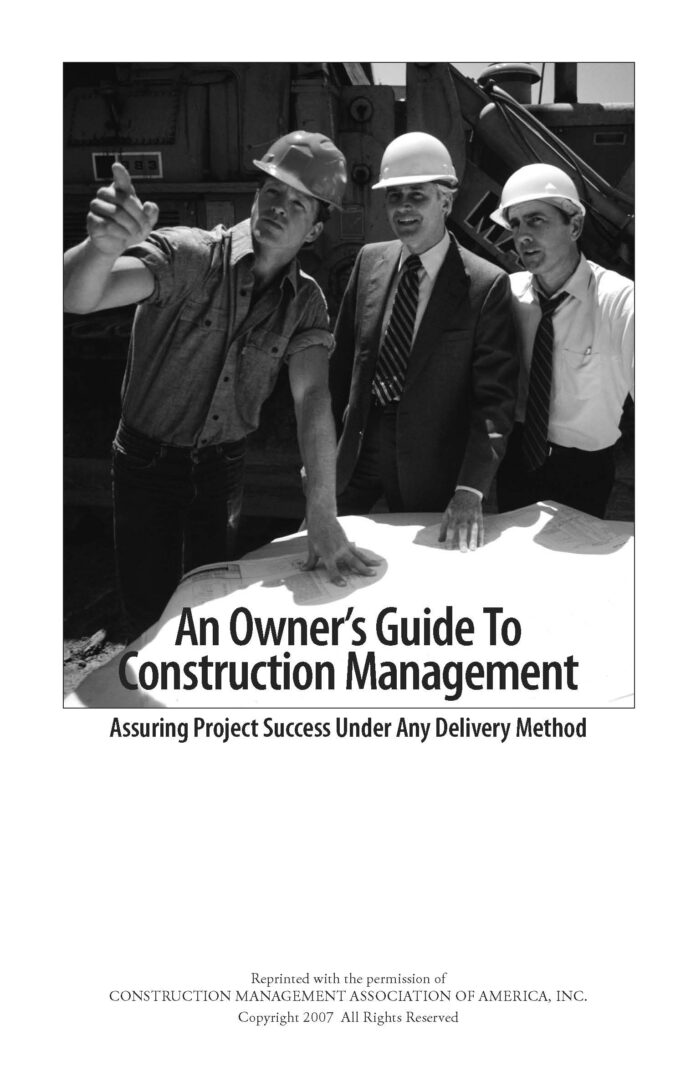Download Free An Owner’s Guide To Construction Management PDF
Construction management evolved as a professional practice distinct from design and construction in the early 1960’s in response to increasing complexities in the construction industry. Highly sophisticated construction systems led to the specialization of both design and construction professionals.
Additionally, increasing regulatory mandates, litigation, and other risks created a need for a new professional to be an advocate for the Owner and bridge the gap between the Owner, the Designer, and the Contractor. Today, construction management is well-established and recognized around the world as an indispensable profession.
A Construction Manager (CM) provides the Owner with specialized knowledge, experience, and resources to navigate through the complexities of a construction program or project. Construction management services may be tailored to satisfy the needs of the novice or sophisticated Owner. The CM adds value by providing the resources and expertise needed to manage quality, cost, schedule, scope, and risks associated with design and construction to help the Owner achieve its objectives.
A major construction effort is a complex and risk-laden venture. It involves the expenditure of a large sum of capital as well as the application of technologies of which many are aware, some are conversant, but few are experts. It requires the Owner to do business with several groups of people whose interests are not its own and to venture into a field with its own set of rules, some of which are not written down anywhere. It is an intensive process demanding constant attention in order to achieve success.
The federal government has a construction budget that is measured in billions of dollars and a plan for accomplishment that is measured in decades. Many state governments have construction efforts of hundreds of millions of dollars and multiple years. Although the federal and state governments have standing staff to manage their typical construction program, they often need specialized expertise or supplemental staff to help manage certain projects.
Smaller government organizations are like smaller businesses, having the same organizational needs for construction expertise matched against an equal need to reduce expenses. Moreover, many times the smaller private Owner cannot afford to build a staff and fully develop sufficient expertise to embark upon a construction program.
The use of professional construction management services to oversee all or parts of the planning, design, and construction process is recognized in both the public and private sectors as an effective and efficient means of achieving successful delivery of constructed projects under any contract format.
The Construction Management Association of America (CMAA ) presents this document as a guide to public and private Owners in selecting a critical component of the construction project: the CM.
This guide will benefit those Owners who will embark on a construction project and who will seek expertise in the planning, design, and construction process. It introduces the construction management practice and describes how it can enhance the success of a project.
Defining Construction Management
There are several issues an Owner must consider in the selection of a method of accomplishing a project:
- Time needs of the project: Does it have to be done quickly? Will the schedule be affected by outside influences? Will the schedule be lengthened by cash flow considerations?
- Needs of the project for flexibility: How much change will be required during the construction? How much of the project will be fully defined by the Owner and Designer prior to its being constructed? If other than the Owner, how much influence will the user have over the design and construction?
- Preconstruction service needs: How much assistance will the Owner need in the definition and planning of the project with respect to quality and safety, and with respect to cost versus scope versus time?
- Design process interaction: How well does the Owner understand the design process and the cost impacts of decisions made in the course of design development? How complex is the design process for the project?
- Financial constraints: How is the project financed? How does the financing influence the schedule, type of contract, risk, and other requirements of the project?
The Project Participants
While a wide and somewhat bewildering variety of project organizations have evolved over time to satisfy the needs of Owners and projects, all share the same basic set of players:
- The Owner: The private or public organization ultimately responsible for the proper execution of the project.
- The Construction Manager (CM): A provider of professional services to the Owner, the CM organizes the effort, develops the management plan, monitors the participants’ progress against the plan, and identifies actions to be taken in the event of deviance from the plan. The CM also provides expert advice in support of the Owner’s decisions in the implementation of the project. The CM can be a firm, a team of firms, or an individual.
- The Designer(s): Employed by the Owner to provide design services in support of the project. While Designers can be contractually responsible to the Owner, they report progress to the CM and are monitored by the CM for compliance with the scope statement and both the design and construction budgets.
- Other Consultants: Providers of specialized services, such as real estate acquisition firms, geotechnical engineering firms, environmental engineers, permitting consultants, etc., employed by the Owner in support of the project. Their efforts are coordinated and monitored by the CM.
- The Contractor: The organization or individual who undertakes responsibility for the performance of the work, in accordance with plans, specifications, and contract documents, providing and controlling the labor, material, equipment, and subcontractors to accomplish the work.





